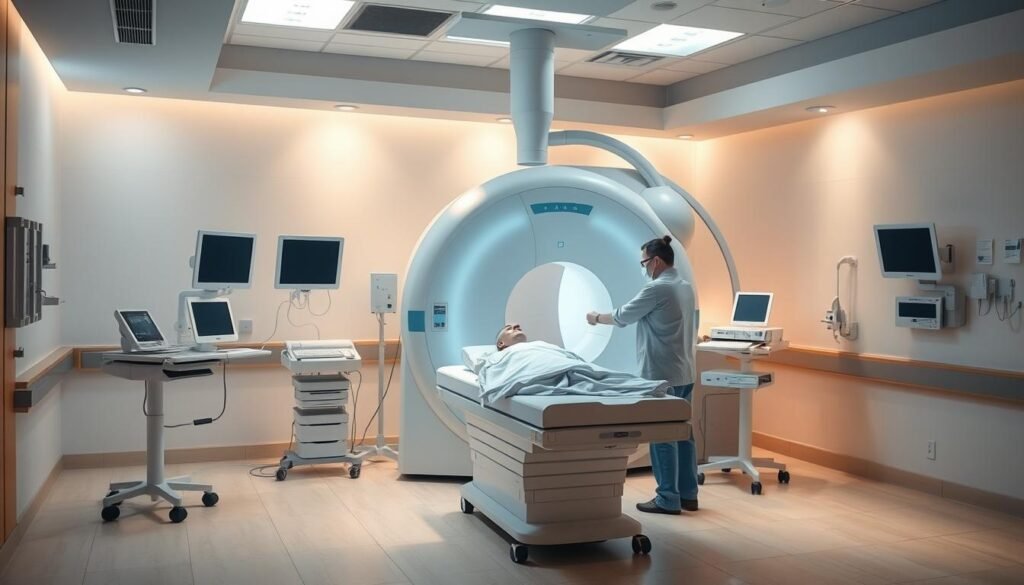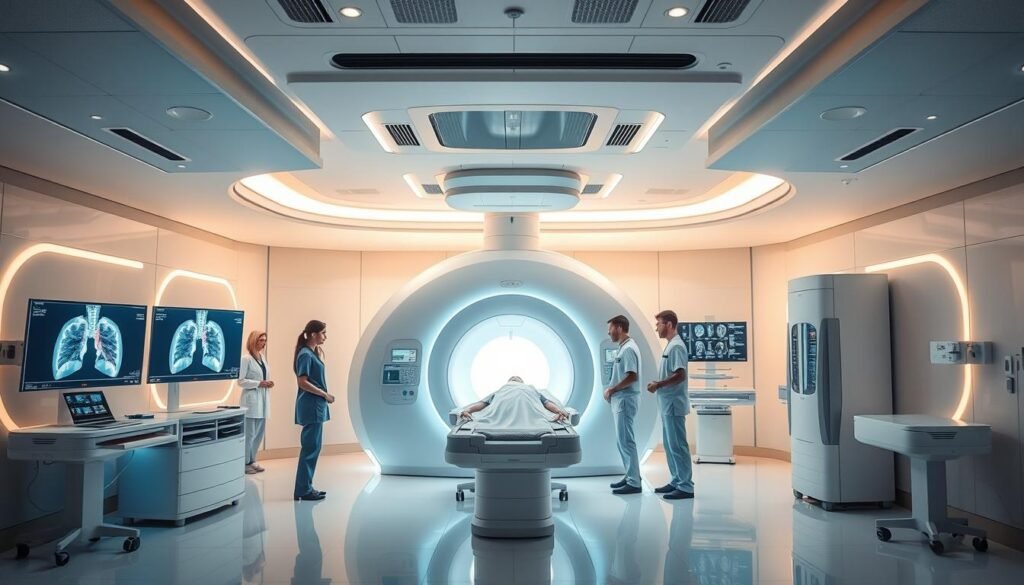Did you know over half of cancer patients get radiation therapy at some stage? This fact highlights how important radiation therapy is in fighting cancers, including lung cancer. Specifically, the 5 day radiation treatment for lung cancer offers a strong approach. It lets patients tackle their illness in less time than longer treatments.
This guide goes deep into lung cancer treatment. It focuses on the benefits and methods of short-course radiation therapy. Since radiation therapy uses high-energy rays to kill cancer cells, knowing how it works can greatly improve treatment effects. It can make the patient’s journey smoother.
Key Takeaways
- The 5 day radiation treatment for lung cancer is an effective option for many patients.
- More than half of all cancer patients may receive radiation therapy during their treatment.
- Short-course radiation therapy can reduce the overall treatment time, enhancing convenience for patients.
- Radiation therapy aims to specifically target cancer cells while sparing healthy tissue.
- Understanding different treatment options empowers patients to make informed decisions.
Understanding Lung Cancer and Its Treatment Options
Lung cancer has two main types: non-small cell lung cancer (NSCLC) and small cell lung cancer (SCLC). Each type affects how doctors decide on treatment. They look at how fast the cancer grows and where it spreads.
Overview of Lung Cancer Types
Non-small cell lung cancer is the most common type and grows slower than small cell lung cancer. Small cell lung cancer spreads quickly and is more aggressive. The treatment options can be different based on the type of lung cancer. They might include:
- Surgery: This is used for NSCLC that hasn’t spread far or SCLC that’s only in one spot. Doctors might remove part of the lung.
- Chemotherapy: Given through an IV, this treatment can be used alone or with other treatments.
- Targeted Drug Therapy: This is for NSCLC with certain mutations. It helps slow or stop the cancer.
- Radiation Therapy: Often used with surgery, it can kill cancer cells left behind or ease symptoms.
- Immunotherapy: A new treatment that helps the immune system fight the cancer.
Importance of Early Detection
Finding lung cancer early can make treatments more successful. People over 50 who smoked a lot should get screened regularly. Teaching people about lung cancer symptoms and how to get screened is vital. It can catch the cancer early, improving the chances of beating it.
If you have lung cancer, your treatment plan will be unique to you. It will depend on the type of cancer, how advanced it is, and your overall health. For more information on lung cancer treatments, go to lung cancer therapy resources.
What is Radiation Therapy?
Radiation therapy uses high-energy rays or particles to kill cancer cells. It’s key for treating lung cancer, with different treatments for each case. This therapy reduces tumor size before surgery, removes remaining cancer cells after, or helps with symptoms in advanced cases.
Definition and Purpose of Radiation Therapy
Radiation therapy for lung cancer aims to manage tumors safely. It destroys cancer cells with high-energy rays, protecting healthy tissues. This method is vital for patients who can’t have surgery, offering a way to fight the disease without invasive procedures.
Types of Radiation Therapy Used for Lung Cancer
Lung cancer treatment involves various radiation therapies. The most common is external beam radiation therapy (EBRT). Radiation targets the tumor from outside the body. Other techniques include:
- Brachytherapy: Places radioactive source near or in the tumor, reducing tumors that block airways.
- Proton therapy: Uses precise protons instead of x-rays, great for Stage III non-small cell lung cancer.
- Stereotactic body radiation therapy (SBRT): For early-stage lung cancers, SBRT needs fewer sessions – one to five treatments.
- Three-dimensional conformal radiation therapy (3D-CRT) and intensity-modulated radiation therapy (IMRT): These accurately map the tumor and adjust beams, minimizing healthy tissue exposure.
Learning about these radiation therapy types helps patients and caregivers choose the best treatment.
https://www.youtube.com/watch?v=5F-kwsSoypg
5 Day Radiation Treatment for Lung Cancer
The 5-day radiation treatment for lung cancer offers a new way to fight this disease. It uses high-dose radiation in just five days. This method targets lung tumors well and makes treatment easier on patients. The aim is to speed up the radiation process for lung cancer. This approach has become more common lately.
Overview of the 5-Day Protocol
This quick radiation plan means getting treated for five days in a row. Each session gives a strong dose of radiation aimed at fighting lung cancer. The goal of the 5-day plan is to make treatment faster. It helps patients spend less time in therapy than traditional methods do. Those can take weeks.
Benefits of a Short-Course Radiation Therapy
Short-course radiation therapy has many benefits. Here are some key points:
- Reduced treatment duration: Speedy radiotherapy means patients finish treatment quicker.
- Enhanced comfort: The shorter plan helps patients keep up with their daily life. This makes sticking to therapy easier.
- Similar efficacy: Research shows short and long treatments control tumors about the same. This proves the short method works.
How Radiation Therapy is Administered
Radiation therapy is vital for treating lung cancer. One main way to do this is through External Beam Radiation Therapy (EBRT). This method focuses on targeting the tumor from outside the body. It uses many advanced techniques to make sure the treatment works well.
External Beam Radiation Therapy (EBRT)
EBRT sends strong radiation beams right at lung tumors. It is painless, similar to getting an X-ray but with more radiation. Patients usually have EBRT sessions five days a week. These sessions help deliver intensive treatment quickly, aiming for the best results in a short time.
Techniques for Treatment Delivery
For better radiation treatment, doctors use strategies like IMRT and SBRT. IMRT shapes the radiation dose to fit the tumor, protecting healthy tissue. SBRT delivers high doses in a few sessions. It works well in 85–95% of early-stage lung cancer cases. Patients have shown promising survival rates after three years.
Setting up radiation therapy involves steps like CT simulations and planning. This can take weeks. A daily session is about an hour, including prep and treatment. Regular checks and talks with the doctor help make the treatment more effective.

| Treatment Technique | Key Features | Effectiveness | Typical Duration |
|---|---|---|---|
| EBRT | Pain-free targeting of tumors | Standard for most lung cancers | 5 days a week for several weeks |
| IMRT | Customizes dose shapes to tumors | Minimizes damage to healthy tissue | Varies based on treatment plan |
| SBRT | High doses in fewer sessions | 85-95% tumor control rate | Typically within a week |
Potential Side Effects of Radiation Treatment
Patients getting radiation therapy for lung cancer may face side effects. These can impact their comfort and overall health. Being aware of these side effects helps in better preparation and management. This improves life quality during treatment.
Common Side Effects Experienced by Patients
Side effects from radiation treatment can differ from person to person. Common ones many face include:
- Fatigue: A common problem, it can limit everyday activities.
- Skin irritation: Treated skin may turn red, sore, or flaky.
- Nausea and vomiting: This might be intense, requiring medicines.
- Difficulty swallowing: Soreness and swelling can make swallowing hard.
- Shortness of breath: This can happen after chest radiation and might last weeks.
Lung cancer radiation can also lead to weight loss due to less appetite. Dietitians might recommend high-calorie drinks for support during treatment.
Management of Radiation Therapy Side Effects
Dealing with radiation therapy side effects requires talking with health experts. To ease these issues, patients can try different strategies:
- Nausea management: Fizzy drinks and ginger can help. Avoid big meals.
- Skin care routines: Soft washing and moisturizing can reduce skin issues.
- Encouraging appetite: Eating small, healthy meals can help with losing appetite.
- Monitoring breathing: Inhalers and avoiding hard physical work can help with breathing problems.
Keeping an open talk about troubling side effects improves care. For more information on effects on body parts, visit this resource.
Is This Treatment Suitable for You?
Finding out if the 5-day radiation treatment for lung cancer works for you involves checking a few things. It’s mostly for people with lung cancer that hasn’t spread and can’t be removed by surgery. If you’re looking for a shorter treatment due to health, age, or preference, this might suit you.
Patients Typically Recommended for 5 Day Treatment
The right patients for the 5-day treatment need careful selection. It’s mainly for those with a kind of lung cancer called non-small cell lung cancer (NSCLC) who can’t handle long treatments. Older patients or those with certain health issues might also find it helpful. This approach aims to treat effectively while reducing discomfort.
Pre-Treatment Evaluations and Considerations
Before starting radiation, a detailed check-up is key. This usually means getting scans like CTs and MRIs to see how far the cancer has spread. Tests to check how well your lungs work and lung cancer treatment assessments help make a treatment plan just for you. These steps make sure the treatment fits your health needs and cancer stage well.

Latest Advances in Lung Radiotherapy
The field of lung radiotherapy is changing quickly thanks to new technology. Now, doctors can target cancer with more precision. This improves how well treatments work for those with lung cancer.
Innovations in Radiation Technology
Advanced tech is changing how we treat lung cancer. With personalized plans, doctors use advanced imaging and artificial intelligence for better targeting. Adaptive radiation therapy adjusts treatments as needed, based on the tumor’s changes. These methods lead to better results and more options for patients.
Future Directions for Short-Course Radiation Therapy
Short-course radiation therapy holds a bright future. Research is combining it with other treatments like immunotherapy. Trials are underway to find the best ways to use this, aiming to reduce side effects. This could change the care for early-stage and hard-to-treat lung cancers.

| Technique | Description | Benefits |
|---|---|---|
| Adaptive Radiation Therapy | Modifies treatment based on real-time data. | Increased accuracy and safety. |
| Stereotactic Body Radiotherapy (SBRT) | High-dose radiation delivered to a precise area. | Improved local control and survival rates. |
| Intensity-Modulated Radiation Therapy (IMRT) | Adjusts radiation dose according to the shape of the tumor. | Reduced incidence of side effects like pneumonitis. |
| Particle Beam Therapy | Uses protons or carbon ions for treatment. | Fewer adverse effects compared to conventional methods. |
| Durvalumab Combination Therapy | Immune checkpoint inhibitor used after chemoradiotherapy. | Extended median survival time in patients. |
Patient Experiences and Testimonials
Learning from patients about their radiation therapy gives us insight into its effects on lung cancer. Positive testimonials on lung cancer treatment show both the good and tough parts of the 5-day protocol. This feedback helps us understand what people go through with this treatment.
Real-Life Experiences with 5-Day Radiation Treatment
A study with nine individuals showed varied patient experiences with radiation therapy. They were mostly 70 years old. Most had outpatient care, but two were in the hospital. Some found out about their cancer during check-ups, while others had symptoms like shortness of breath and weight loss.
They shared their feelings about the treatment:
- Hope and fear about how it would work.
- Dealing with tiredness, pain in the throat, and feeling sick.
- Feelings of guilt and pride in managing treatment with help from doctors.
Summary of Patient Feedback
The overall patient feedback on lung cancer treatments is pretty good. People liked the quick pace of the 5-day treatment. They also valued support from health care teams. Here’s what they said:
| Aspect | Positive Feedback | Challenges Faced |
|---|---|---|
| Overall Satisfaction | Ninety percent were happy with their results | Getting to the hospital every day |
| Support | Great trust in their doctors | Handling side effects of other treatments |
| Quality of Life | Better energy after treatment | Getting used to living with cancer |
Though there are hurdles, most people feel good about their 5-day radiation therapy. Much of the positive vibe comes from the tailored care and constant motivation from the medical team.
Conclusion
The 5-day radiation treatment for lung cancer offers new hope for patients. It shortens treatment time but still works effectively. With new tools like IMRT and SBRT, patient outcomes and satisfaction could get even better.
Knowing about all lung cancer treatments helps patients make smart choices. They can work with doctors to pick the best plan. This might boost survival rates and life quality, making the 5-day treatment a key option.
Understanding treatment options is vital for anyone facing lung cancer. The latest radiation methods are part of these options. With good support and the right care, many patients see positive results and find the path a bit easier.